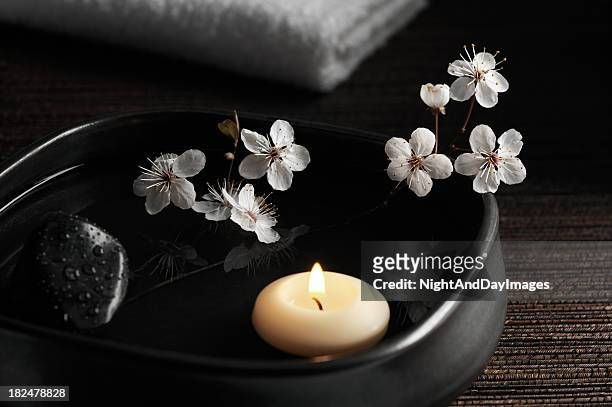What Decorations Can You Put In Candles?
Candle decorations refer to any adornments added to the outside of a candle to enhance its appearance. From dried botanicals to glitter and gems, candle decorations allow you to customize the look of candles in countless creative ways. Popular options range from simple to ornate, but all candle decorations serve to make plain candles more visually interesting.
When decorating candles, it’s important to take proper safety precautions. Only add decorations to pillar candles or containers, not taper candles which can tip over easily. Use fire resistant materials only and avoid decorations that could clog the wax pool. Place decorated candles away from drafts and flammable materials. Follow all manufacturer guidelines on burn times and proper wick trimming. With some caution and creativity, decorating candles can be a fun way to add personalized flair to your home décor.
Dried Flowers
Dried flowers are one of the most popular decorations for candles. Their delicate petals and vibrant colors provide a beautiful accent to candle designs. When working with dried flowers, there are a few tips to keep in mind:
Some of the most popular types of dried flowers used in candles are roses, lavender, baby’s breath, and hydrangeas. Roses hold their shape well and provide lush, romantic tones. Lavender offers a fresh, calming fragrance in shades of purple. Baby’s breath is ideal for wrapping around candles with its tiny blossoms and filler greenery. Hydrangeas come in a range of colors from white to pink to blue.
Proper drying is crucial for flowers to retain their shape, color, and fragrance. Cut flowers in the early morning when they are coolest and full of water. Remove any leaves or stems that will be below water level in the vase. Use a low temperature setting on a food dehydrator, or hang flowers upside down in a dark, dry area. Let air circulate around the flowers, but make sure they are out of direct light. Drying time can take 1-3 weeks.
When arranging dried flowers in candles, use hot glue on the wicks or bottom edges of the inside of the container. Place your flowers how you envision, using odds numbers of blooms in groupings. Mix heights, colors, and varieties for visual interest. Keep things from feeling too crowded. The flowers will provide a lovely natural decoration as the candle burns.
Glitter
Glitter is a popular and festive decoration that can add sparkle and shine to candles. There are a few types of glitter that work well with candles:
- Fine grain glitter – This very fine glitter works best as it will not clog the wick as larger pieces can. Go for a superfine glitter or ultra fine glitter.
- Heat resistant glitter – Special heat resistant glitter is designed not to lose its color or melt when exposed to the heat of a burning candle. This is the best choice for candle making.
- Chunky glitter – Larger pieces of chunky glitter can be mixed with wax and poured into molds for an embedded glitter effect.
When adding glitter to candles, it’s best to mix it directly into melted wax before pouring into the container. Use 1-2 teaspoons of glitter per standard jar candle. Stir well to fully distribute.
For creative techniques, ombre glitter candles provide a fade effect. To make them, pour plain wax first, let set, then sprinkle glitter and pour a final thin later of wax over the glitter to seal it in. The candle will burn through the glitter, providing a sparkly ombre finish.
Seashells
Seashells can make for beautiful candle decorations with their natural shapes and textures. When choosing seashells to put in candles, small, thin shells tend to work best. Large, thick shells may prevent the candle from burning properly. Some of the best varieties to use include:
- Sand dollars – These flat, round shells lie neatly on the candle surface.
- Scallops – Known for their ribbed, fan-like shape.
- Clam shells – Small clam shells work well.
- Periwinkles – Tiny spiraled snail shells.
- Cockles – Heart-shaped shells with ridges.
Before placing seashells in candles, make sure to clean them properly. Rinse off any dirt or debris under water. You can use a small brush to scrub them clean. Avoid soaking them for too long, as excess water can cause them to deteriorate over time. Allow the shells to fully dry before putting them on candles.
When arranging seashells, consider alternating shapes, sizes, and orientations for visual interest. Group a few shells together or scatter individually. Place some shells opening-up, some on their sides, some facing down. Experiment with different patterns and placements to find what you like best. Just take care not to overload the candle or obstruct the wick, as this can impact burning.
Fruit
Fruit can make for beautiful and fragrant candle decorations. Citrus fruits like orange and lemon slices work particularly well. Before adding fruit to candles, it helps to prepare the fruit by drying it out. This prevents excess moisture from disrupting the candle wax. To dry fruit, simply slice it and leave the slices out for 1-2 days until most of the moisture has evaporated. The fruit slices will look shriveled when ready. Arrange the dried fruit slices on the top of the candle before lighting. The heat from the candle will release the fruit’s aromatic oils, infusing your space with a lovely, fruity scent. Take care when burning fruit-decorated candles, as fruits high in water content can cause more smoke. Dried citrus slices are ideal for fruit candle decorations.
Herbs and Spices
Herbs and spices are a popular decoration to add visual interest and fragrance to candles. Some common herbs used include lavender, rosemary, basil, thyme, sage, and mint. The herbs can be used fresh or dried. If using fresh herbs, make sure to dry them completely before adding to candles so the moisture doesn’t cause issues when burning.
Dried herbs and spices like cinnamon sticks, whole cloves, star anise, curry leaves, and peppercorns make eye-catching decorations. Herbs with woody stems like rosemary, thyme, and sage look beautiful wrapped into mini wreaths and garlands around candles. Make mini wreaths by gathering several herb stems into a ring shape and securing with floral wire.
When drying fresh herbs for candles, it’s important to hang them in a dark, dry, warm area with good airflow. Hang herb bundles or lay single stems on trays. Drying time can range from 1-2 weeks. Herbs are fully dry when they crumble easily. Once dried, store herbs in airtight containers until ready to use. With some creativity, herbs and spices can add natural decoration and wonderful aromas to homemade candles.
Wax Shapes
Embedding custom wax shapes into candles can add fun and creative designs. There are a few different methods you can use to make custom wax shapes for candles.
How to Make Custom Wax Shapes
One way is to use silicone molds. Silicone molds are flexible and make it easy to pop the finished wax shape out of the mold. You can find all kinds of fun silicone mold shapes like stars, hearts, flowers, seashells, and more. Simply melt wax and pour a thin layer into the mold cavity. Let it cool completely before removing from the mold.
Another option is to use candy melts or modeling chocolate to hand-make shapes. Candy melts are easy to work with and come in a variety of colors. Let the shapes cool completely before embedding into melted candle wax.
Modeling chocolate makes durable shapes that hold their form well when embedded in candles. It can be colored easily with food coloring. Let the shapes dry completely before using in candles.
Embedding Shapes in Candles
To embed shapes, pour a thin layer of melted wax into the candle container and let it partially set up. Then gently press the wax shapes into the softened wax in the desired pattern. Pour more melted wax over and around the shapes to hold them in place.
For best results, use wax shapes that are the same wax type as the candle wax. This helps them adhere together nicely. Allow the candle to fully set up before burning.
Types of Molds
Silicone molds come in all kinds of fun shapes like animals, flowers, geometric patterns, and more. Clear silicone molds let you see the wax color as it sets up.
Plastic molds can be used as well but may not release the shapes as easily. Metal and glass molds are not recommended because the wax contracts when cooling and can crack or stick.
Custom molds can also be made from clay or modeling plastic, for truly unique wax shapes.
Glitter
Glitter is a fun and festive way to decorate candles. There are many types of glitter suitable for candles, but finer glitters tend to work best. Finer glitters will scatter light nicely when the candle is lit. Some good options are ultra fine glitter, disco dust, and mica powder.
To add glitter to candles, first make sure the wax is slightly cooled but still soft. Then, take a spoon and sprinkle glitter over the top, or dip the rim of the candle in glitter to coat it. You can add different colors of glitter for an ombre effect. For more creative options, try making patterns with stencils or adding stripes or polka dots of glitter.
Glitter candles look beautiful grouped together for centerpieces. You can also roll taper candles in glitter to make glittery taper candles. Just be sure to use only non-combustible glitter intended for candle making.
Gems and Crystals
Gems and crystals can add a beautiful, mystical touch to candles. Some of the best gems and crystals to use in candles include:
- Rose Quartz – Known as the love stone, rose quartz brings feelings of harmony and peace.
- Citrine – This bright yellow stone promotes optimism and creativity.
- Amethyst – Amethyst has a calming energy that encourages reflection and intuition.
- Clear Quartz – Clear quartz amplifies energies. It works well with any intention.
- Labradorite – With its iridescent colors, labradorite encourages imagination and relaxation.
When arranging gems and crystals in candles, make sure they are on the smaller side, roughly 1 cm or less. This ensures they don’t protrude or become fire hazards. Press them gently into the wax before it fully hardens. Space them out evenly for maximum impact.
Take care when using fiery or brittle stones like amber or obsidian. The heat can cause them to crack or pop. Also avoid stones like malachite that can release toxic fumes when heated. Do research on any potential reactions between your chosen crystals and an open flame.
Conclusion
As this article has shown, there are plenty of fun and creative ways to decorate candles to make them unique. The possibilities are nearly endless with ingredients found in your home, yard, or local craft store. Dried flowers, fruit slices, glitter, gems, herbs, spices, wax shapes, and more can all be used to decorate votive candles, pillar candles, tapers, tealights, and other candle varieties.
When decorating, be sure to follow safety precautions. Only add non-flammable decorations and avoid anything that could clog the wick like seeds or pulp. Light candles in a safe place on a heat-resistant surface, out of reach of children and pets. Trim wicks to 1⁄4 inch before lighting to prevent excess sooting. Never leave burning candles unattended. With some simple precautions, you’ll be able to safely create one-of-a-kind decorative candles to light up any space.


